

Shelves and racks are essential storage solutions in most homes, offices, warehouses, and storage centers, but the two terms are often used interchangeably, leading to confusion about their actual differences. While shelves and racks may seem similar, they have distinct features that make them ideal for specific purposes.
This comprehensive article aims to provide a clear understanding of what shelves and racks are and the key differences and similarities between them. It will also compare their advantages and disadvantages, helping readers make an informed decision when choosing between a shelf and a rack.
Whether you need additional storage space, want to organize your inventory, or simply want to optimize the space, this article will provide all the information you need to determine which option is best for you.
Before we go into details of shelf vs. rack, it would be more appropriate to throw some light on shelves and racks. That will help you understand the compare-and-contrast section of our article in the succeeding paragraphs.
A shelf is a flat surface designed to hold objects and materials, typically in a horizontal position. It is usually supported by brackets and wall mounts or could also be a freestanding unit. Shelves come in a variety of sizes, shapes, and materials to meet the specific needs of different users.
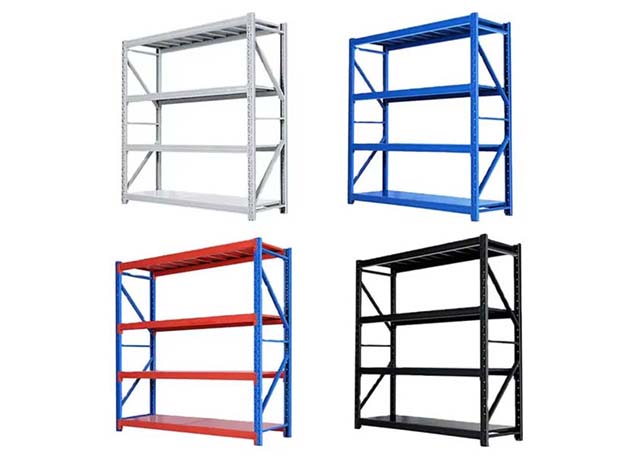
You will have shelves in your homes, too. But since we are talking about the industry level, in the lines below, we have taken a closer look at different types of shelves commonly used in various industries.
These shelves are made of metal, typically from steel, and are designed for industrial and commercial use. They are strong, durable, and can withstand heavy loads, making them suitable for use in workshops, warehouses, and other heavy-duty storage areas. They come in a range of sizes and styles to suit different storage needs.
These shelves are made of particle board and are held together by metal clips or rivets; you can assemble them quickly and easily. They are suitable for lighter loads, making them ideal for homes, offices, or warehouses with limited storage needs.
They are also available in a range of sizes and styles to suit storage needs peculiar to your business.
These shelves are mounted on wheels or casters, making them easy to move from one location to another. They are ideal for use in offices, libraries, and other areas where storage space is limited and mobility is important. Like other types of shelves, they are available in a range of sizes and styles to accommodate your various storage needs.
Shelves are highly versatile and can be used in a variety of settings—from home to retail stores to warehouses. They can be used to store a wide range of items, such as books, decorations, kitchen utensils, and electronics.
Shelves are an excellent way to save floor space, especially wall-mounted shelves, as they utilize vertical space. This makes them ideal for small homes or warehouses where floor space is limited.
Shelves can also be used for decorative purposes, as they can be styled and arranged to enhance the look of a setting. Floating shelves, for example, are popular for their minimalist design, while corner shelves can be used to display unique or sentimental items.
While shelves may be aesthetically pleasing, they are typically designed to hold lighter items and may not be suitable for heavy items, such as large appliances or heavy books. So, if you have a warehouse that stores heavy items, we recommend going for a racking system.
Shelves, especially wall-mounted shelves, have limited storage space, making them unsuitable for larger items. Additionally, items stored on shelves may be difficult to access, especially if the shelves are too high.
Now that we have covered shelves in detail, let's move toward racks!
A rack is a structure designed to hold and organize objects and materials, typically in a vertical position. Unlike shelves, which are usually flat surfaces, racks usually have multiple levels or horizontal bars, making them ideal for storing heavy items that need to be easily accessed.
There are many types of racks used for a variety of purposes, such as wine racks, display racks, server racks, and so on. However, since our focus is only on racks designed for storage purposes, we will cover only some of the basic types of storage racks.
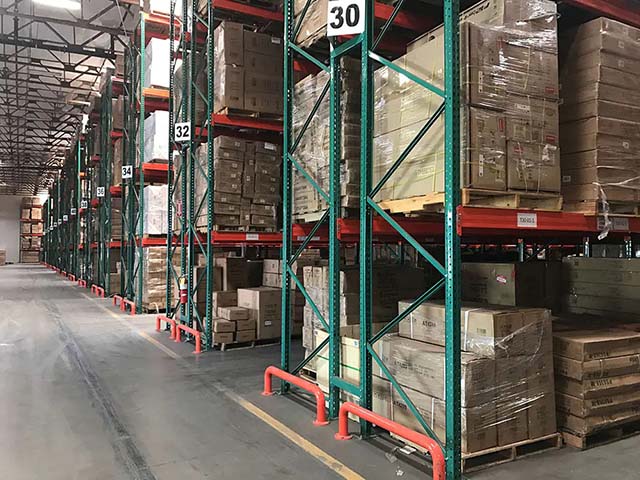
Selective pallet racking is the most common type of storage rack and is designed to store pallets in a neat and organized manner. They consist of uprights, beams, and decking and provide direct access to each pallet, allowing for easy and efficient picking and retrieval of items.
Narrow aisle racking is designed to maximize storage density and is ideal for facilities with limited floor space. They have a narrow aisle width, allowing for more storage space in the same footprint as a traditional selective pallet rack. Narrow aisle racks require specialized handling equipment, such as narrow aisle forklifts, to access the stored items.
Cantilever racking is designed for storing long or irregular items, such as lumber, pipes, or furniture. They consist of vertical columns and horizontal arms projecting out from the columns to support the stored items. Cantilever racks provide ample clearance for items that can’t be stored on traditional shelves or pallet racks and are ideal for facilities with heavy or long items that need to be stored off the ground. They are also adjustable, allowing users to customize the rack to meet their specific storage needs.
Drive-in racking is similar to pushback racks but allows for the use of forklifts to drive into the rack to access stored items. They are designed to store pallets in a deep, high-density configuration and are ideal for facilities with high storage volumes and low product turnover.
Carton flow racking is a pallet rack system designed for efficient and organized storage of cartons, boxes, and other similar items. These racks feature a series of inclined shelving levels that allow items to “flow” towards the front of the rack, making it easier to access and retrieve items. The shelves are mounted on rollers or wheels, which allow the items to move smoothly from one level to the next. Carton Flow Racks are commonly used in distribution centers, warehouses, and other high-volume storage facilities where speed and efficiency are essential.
These are some of the types. Head to our main article on the types of pallet racking to know more about which type of racking system would serve your needs best.
What makes storage racks better than shelves? Let's discuss it!
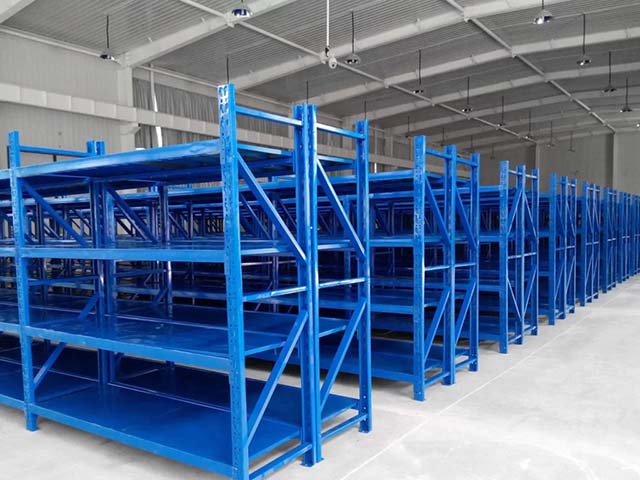
Racks are designed to hold heavier items than shelves, making them ideal for storing large or heavy items, such as appliances, tools, or heavy and bulky goods.
But it is not just the increased capacity that makes racks suitable for warehouses. They also have multiple levels or horizontal bars, providing more space for storage than shelves. So, if your storage center has to house more goods, a racking system is your go-to solution.
Lastly, racks are designed to help organize items, making it easier to find what you need. They can be used to separate items by type, size, or purpose so that it is easier to keep your goods and stored items tidy and organized.
Shelf capacity is limited by its flat surface, which can only hold a limited amount of weight before collapsing. For example, if you’re storing books, a shelf might be able to hold several hundred pounds, but if you’re storing heavy machinery parts, it might only be able to hold a few dozen pounds before breaking.
Racks, on the other hand, can hold much heavier items because they have multiple levels or horizontal bars that provide support. Racks are designed to withstand significant weight and can be used to store heavy items such as pallets of goods or heavy machinery.
Shelves provide a flat surface for storing items but can take up a significant amount of floor space. For example, a shelf that is 6 feet wide and 2 feet deep will take up 12 square feet of your floor space.
In contrast, racks can be designed to maximize vertical space, providing more storage in the same floor space as shelves. This makes them ideal for facilities with limited floor space. For example, a multi-level rack system can store several pallets of goods in the same space that a single shelving unit would occupy.
Shelves offer direct access to all stored items, making picking and retrieving them easy. You can easily see and reach for a book or anything placed on a shelf.
Racks, on the other hand, are designed for specific purposes, such as storing heavy items or displaying merchandise and may not provide direct access to all stored items. For example, with a drive-in rack system, you would need to drive a forklift into the rack to access the stored items.
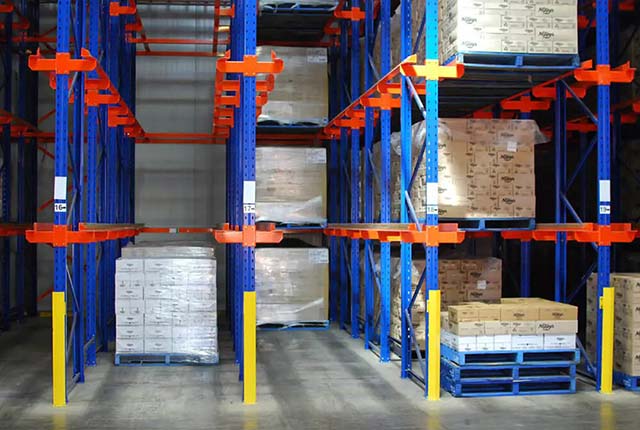
Shelves can be used to store a variety of items, but they may not provide the same level of organization as racks. Racks are designed to help organize items, making it easier to find what you need. They can be used to separate items by type, size, or purpose—this makes it easier to keep your belongings managed and organized. For example, a selective pallet rack system can be used to store pallets of goods in a neat and organized manner, with each pallet accessible without having to move other pallets first.
The cost of shelves and racks can vary greatly depending on the material used, size, and design. However, in general, shelves are often less expensive than racks because they are simpler structures. Racks, on the other hand, may cost more due to their specialized design and increased weight capacity.
For example, a basic shelving unit might cost a few hundred dollars, while a multi-level drive-in rack system could cost several thousand dollars.
Want to know more about the cost of pallet racking? Read our detailed article on pallet racking costs.
Shelves are available in a variety of materials, including wood, metal, and plastic, each with its own strengths and weaknesses in terms of durability. A solid wood shelf may be more durable than a metal shelf if it’s well-constructed, but wood can also be susceptible to warping, cracking, or rotting over time. In contrast, metal shelves can be extremely durable but may rust or corrode if exposed to moisture or corrosive elements.
As far as racks are concerned, they are typically made of metal, making them more durable and resistant to damage than shelves made of other materials. However, the durability of a rack will also depend on factors such as the quality of the metal, the design, and how it’s used.
Both are safe, but the safety depends upon their installation and maintenance.
Shelves need to be installed and used correctly to ensure safety. To keep them safe, shelves should be securely attached to the wall to prevent collapsing if overloaded. Improper installation or usage of shelves can lead to accidents such as collapsing, causing injury or damage.
Similarly, racks need to be installed and used correctly to ensure safety. For example, pallet racks need to be anchored to the floor to prevent tipping over if not loaded properly. Improper installation or usage of racks can also lead to accidents such as tipping over, injury or causing other damage to goods and human resources.
Shelves can be customized to some extent by adjusting the height, but their design is limited to simple flat surfaces. Racks offer much more customization options, including the ability to add different levels and configurations to maximize storage space. For instance, selective pallet racks allow for multiple storage levels and the flexibility to store different items on each level.
The maintenance required for a shelf will depend on the material and design. For example, wood shelves may require refinishing or treatment to maintain their appearance, while metal shelves may require rust-preventative treatments.
Likewise, racks also require maintenance, depending on the material and design. For example, metal racks may require rust-preventative treatments, while plastic racks may need cleaning to maintain their appearance.
Shelves may be affected by environmental conditions such as exposure to moisture or extreme temperatures. A wood shelf exposed to moisture may warp or rot, while a metal shelf exposed to high temperatures may expand and become unstable.
Racks, being typically made of metal, may be more suitable for use in environments with high moisture or temperature extremes compared to shelves made of other materials. At the same time, a plastic rack may be more suitable in a damp environment, as it is less susceptible to rust and corrosion.
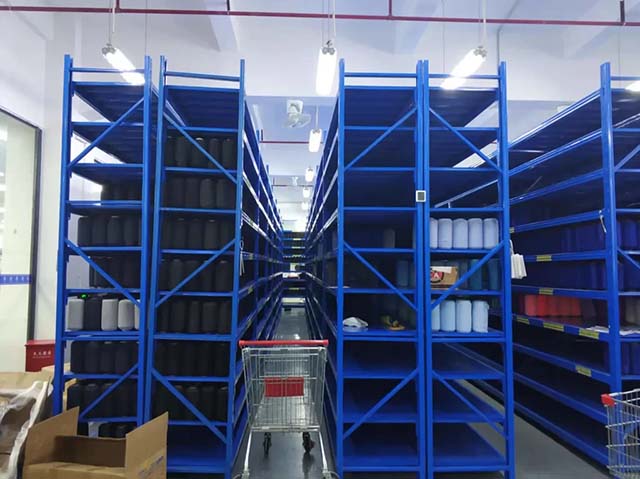
When choosing between shelves and racks for storage, it’s important to consider the type of items you will be storing, as well as the weight and size of those items. If you are going to store heavy items or items of unusual size or shape, then a rack may be the best option, as they are designed to handle heavy loads and can be customized to accommodate specific storage needs. On the other hand, if you will be storing lighter items, such as books, papers, or household goods, then a shelf may be more suitable.
Additionally, if you need to frequently access your stored items or if you need mobility, then a shelf mounted on wheels or casters, or a mobile storage rack may be a better option. Ultimately, the choice between shelves and racks will depend on a variety of factors, including the type of items being stored, the weight and size of those items, and the storage environment. It's important to carefully consider these factors to determine the best solution for your storage needs.
If you are unsure, worry not! We have got you covered. Let us know, and we will suggest a system that would align with your needs and business goals.
Shelves and racks serve different purposes and have different strengths and weaknesses. The comparison of shelves vs. racks involves careful consideration of several factors, including capacity, space, accessibility, organizing ability, cost, durability, safety, customization, maintenance, and environmental conditions. The choice between a shelf and a rack will depend on the specific storage needs and requirements of the user.
If you need to store light or flat items, a shelf may be the best choice. However, if you need to store heavy or awkward items, a rack may be the better option. It’s important to carefully consider the specific needs of your storage area and choose the option that will provide the best combination of capacity, space, accessibility, organization, and cost.